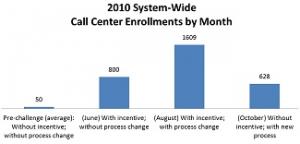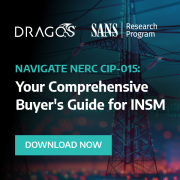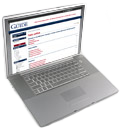Green Power Supercharge

Over the past decade, utility green power programs (also known as green pricing programs) have helped utilities across the nation meet growing customer demand for electricity generated using renewable resources, as well as support both large- and small-scale local renewable energy projects. Additionally they’ve helped utilities improve relations with utility commissions, local environmental groups, and other key stakeholders. Plus utilities have gained direct experience in markets for trading renewable energy certificates (REC), helping them better utilize this market to meet state or regional renewable portfolio standards.
The results of such programs have been impressive. According to the National Renewable Energy Laboratory (NREL) green power program sales reached 5.2 million kilowatt-hours in 2009, the last year for which such data is available.(1)
During call center initiatives, a pattern often emerges—a small minority of CSRs end up enrolling a large majority of total customer enrollments. It’s the 80/20 rule in action. These “high achievers” were asked what the secret was to their success—and the four pieces of advice they offered most frequently were:
■ Bring up the program as much as possible: You never know who is going to be interested in green power. A good rule of thumb is that every new connect and transfer of service should automatically get a program explanation.

■ Be upfront with the fact that this is a voluntary program: “Our utility offers a completely voluntary environmental program called…”
■ Get comfortable with describing the program: Explaining the program will feel awkward at first. However, with time, if will easily roll off the tongue.
■ Lower expectations and don’t worry about rejection: A 10 percent enrollment rate is good—therefore you can expect at least 9 in 10 customers to say no. And once a customer says “no,” just quickly move on to the next part of the call— don’t worry about wasting another breath.–AC
This represents a compound annual growth rate of 20 percent from 2005 to 2009, an impressive growth rate in almost any industry.
Of course, as is true in any maturing market, we should expect that maintaining this rate of growth will prove difficult; this is especially true given today’s difficult economic environment. Fortunately, there are several highly effective, low-cost opportunities to leverage existing utility communication channels for continued program growth.
One of the most effective channels for driving such low-cost growth can be found in what is, perhaps, an unexpected place—the call center. Call center representatives (CSR) serve a special role in utilities—they are on the front lines, representing the utility in personal interactions with customers hundreds of times a week. And by definition, inbound CSR interactions always occur while the customer is proactively making a decision about their energy use.
The traditional focus at most utility call centers is on addressing customers’ immediate questions and maintaining reasonable call handling times, not on enrolling customers in voluntary programs. However, with good planning and concise training, CSRs can be one of a utility’s most successful options for enrolling customers—with no significant impact on call-handling time.
Training and Incentives
Every successful call center initiative starts with CSRs that have learned about the green power program and become comfortable describing it to customers. The following best practices can help ensure that this training results in higher program enrollments, without any impact on overall customer service:
■ Avoid any hint of “sales”: CSRs aren’t direct sales people. In fact, many CSRs have specifically chosen to work at utility call centers so that they don’t have to engage in sales. For this reason, repeatedly explain to CSRs that no one is expected to “sell” the program. Instead, instruct CSRs that educating customers about their options is an aspect of good customer service: customers have a right to know about the green power opportunities available through their utility. This distinction helps many CSRs feel comfortable explaining the program to customers, and they often quickly find that they don’t need to sell the program— and that, in fact, it sells itself.
Case Study: Blue Sky Call Center Contest
A call center serving customers of Pacific Power and Rocky Mountain Power has successfully engaged in a Blue Sky Contest annually for the past three years. Prior to any contests, the call center averaged approximately 50 enrollments each month. During contest time frames, the call center enrolled upwards of 800 customers in the Blue Sky program each month.
To continue to achieve increased enrollment rates per month, the utilities implemented best practices and lessons learned from previous contests, which included:
■ Timing: Take advantage of the high number of “new connect” calls occurring during the late spring and summer months due to the summer moving season; customers calling to start service are the most likely to consider enrolling in an optional program.
■ Prizes: Surveying CSRs to learn which prizes they liked most.
■ Training: Having the CSRs who were most successful in enrolling new customers train their peers. This heightens CSR engagement in the contest and allows the most successful CSRs to share tips with others.
■ Incentive structure: Include individual, team-based, and call center-wide prizes to motivate broadly and ensure that even the most successful CSRs always have a new goal to work toward.
■ New and improved tools: Better, more concise handouts and translations of materials into Spanish.
In addition to the best practices described above, Pacific Power and Rocky Mountain Power made technological enhancements including more effective scripting on prompt screens and process changes that make the enrollment process easier for the CSRs. These enhancements took place during the 2010 Blue Sky contest, and the CSRs enrolled 3,615 customers during this contest— more enrollments than the previous two contests combined.(2)–AC
■ Provide sample recordings: New CSRs and those that are struggling to talk to customers about the green power program often find it helpful to listen to the language and techniques of successful CSRs. Work with call center managers to collect several recorded calls, including both callers who enroll and callers who do not. Then provide these recordings to the CSRs, so that they have examples to mimic and learn from. This technique can also be helpful in ensuring that CSRs don’t feel pressure to sell the program; recordings of successful calls will prove that a brief but clear explanation of the program is all that is required.
■ Emphasize use of a 3X5 Card: Many CSRs have found that a small 3X5 card that can be taped to their monitors is useful in prompting key points while explaining the program. Full-page handouts are too usually too large and often get filed and forgotten.
Once CSRs are well trained and comfortable talking about the green power program, a short-term call center contest can help reinforce that training in a fun and engaging way. Key components of such a contest include center-wide goals for enrollment, individual incentives and prizes to reward CSRs for enrolling customers in the program, and public recognition for individuals and the call center as a whole for achieving benchmarks.
Implementing a successful contest takes time and planning but can be well worth the investment. (See sidebar) And, though many call center managers are often initially worried about distracting CSRs with these contests, they eventually realize that these concerns are unwarranted. In fact, they find that the contests provide CSRs with a low-pressure but exciting incentive, encouraging high-quality job performance and recognizing employees who put in extra effort.
Individual call center contests can be as short as a couple of weeks or as long as 2-3 months. Longer contests are often more effective than shorter ones, because it can take a while for CSRs to get comfortable talking about the program and to appreciate the recognition and prizes that accompany success. In addition, it is recommended that CSRs be recognized based on enrollments per hour worked rather than just total enrollments—this levels the playing field for CSRs that work part time.
It is also suggested that these contests use point systems to reward CSRs who enroll customers in the green power program. As demonstrated in this poster from the Dominion Green Power program, CSRs can then redeem these points at a green power “store” for a variety of prizes. (See Dominion Poster) Providing CSRs with a variety of prizes helps ensure that all of the CSRs will have some incentive to stay engaged in the contest.
Best Practices and Benefits
The Blue Sky Contest served to double enrollment levels in the case study’s call center both during and following the contest. The contest didn’t increase or negatively affect any other aspect of call center performance, and it cost approximately $10 per customer enrolled.
Short-term call center contests are effective, but they aren’t the only way to increase call center green power program enrollments. Ongoing, long-term initiatives can also be successful; for example, the Sacramento Municipal Utility District (SMUD) increased annual enrollments through their call centers by 819 percent by beginning to offer CSRs a $5 incentive for each customer enrolled in the program.The benefits of a longer-term, ongoing call center initiative include better resource management and better customer service. While short-term contests require short, intense bursts that result in periodic spikes in enrollment, a long-term, ongoing initiative leverages initial planning efforts to generate results throughout the entire year. Over time, CSRs get better and better at describing and talking about voluntary green power programs. Long-term, ongoing incentives encourage each CSR to continue practicing and become more effective in describing the program to customers.
Additionally, ongoing call center programs represent a low-cost way to produce successful results. The purpose of voluntary green power programs is to allow customers that want to support renewable energy to do so. But, as with many marketing activities, telling customers about the program can be costly, with funds spent on advertising, event sponsorship, or other “outbound” marketing activities. Given the low marginal costs involved in a long-term, ongoing call center initiative, such an “inbound” activity can be a highly cost-effective option for communicating with customers about the utility’s green power program.
Plus these programs serve to strengthen morale at call centers. CSRs appreciate knowing that their ongoing efforts provide help support renewable energy projects and provide the utility with positive recognition.
The key to a successful program is to follow and maintain a best-practices approach. In addition to basic program principles involving training and incentives, some other tactics include the following:
■ Train all new hires: The best time to teach CSRs about the green power program is when they are learning about everything else. Develop specifi c, concise materials geared for new CSRs that are still learning the basics of their new job. This is an excellent opportunity to make green power program communications a normal part of their day.
■ Keep resource tools updated: CSR resource kits provide relevant program information in an easy to reference format. Resource kits should include product descriptions, Frequented Asked Questions (FAQs), detailed pricing estimates based on customer usage, and a simple script. Even though a 3x5 card is all that is needed the majority of time, having these resources available and up-to-date engages and reassures CSRs.
■ Get management involved: Take the time to involve a Vice President or senior official in trainings or at the launch of a call center contest. This reinforces the fact that there is high-level backing for the green power program, and that support for renewable energy is a core company value.
■ Call waiting and hold message: Most large utilities take pride in short average wait times for their customer service centers. However, when customers do spend a few seconds on hold, it can be a good opportunity to raise customer awareness of the green power program. Develop a catchy, up-beat hold messages to create awareness for the utility program.
When executed properly, call center initiatives are a cost-effective option for engaging, educating, and enrolling customers in your green power programs, and can play an important role in a utility’s overall green power program communications strategy. And, if such strategies also include intelligent outreach at events, direct mail, public relations, Internet, and community partnership activities, utilities will find that they can dramatically increase green power program enrollment, allowing them (and their customers) to play a leading role in accelerating the development of a low-carbon, renewable energy economy.
ENDNOTES:
(1) Green Power Marketing in the United States: A Status Report (2009 Data), Bird, L.; Sumner, J., page 5
(2) In 2008, the call center enrolled 1,350 customers during the contest. In 2009, they increased that number to 1,626. In total, the two call center contests enrolled 2,976 customers—639 enrollments less than the 2010 contest alone.
ABOUT THE AUTHOR: Adam Capage is vice president of utility partnerships at 3Degrees, a provider of voluntary green power program services to utilities. In 2010, 3Degrees was recognized with the U.S. Department of Energy’s Non-Utility Green Power Supplier award in 2010 for the fourth straight year. Email Adam at acapage@3degreesinc.com.




